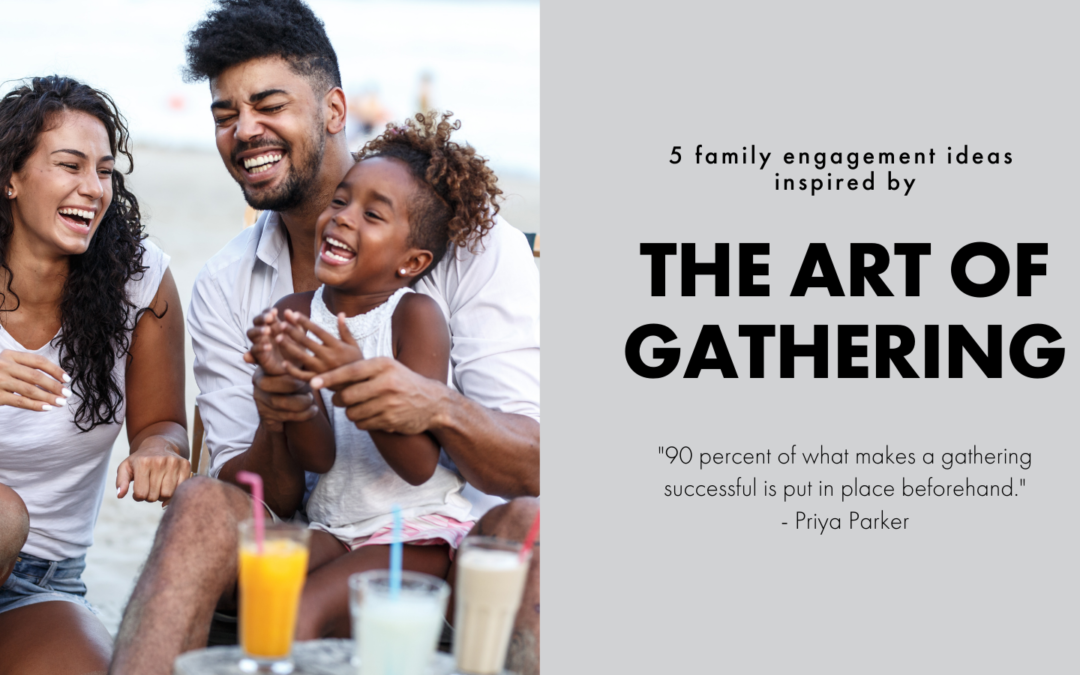The Art of Gathering by Priya Parker was an incredible book that we read in the mastermind. I highly recommend it. The text will challenge you to reimagine what your gatherings could look like and help you improve them from small to grand gestures. Here are 5 family engagement ideas that will help you improve your school gatherings. I’ll share the gist of each idea in this resource, you can get the book here if you want to investigate further along with other suggestions Priya Parker shares.
Close Doors
When we think of family engagement, we think of all families. This actually hurts the gatherings you hope to create. Parker states, “Thoughtful exclusion, in addition to being generous, can be defining. It can help with the important task of communicating to guests what a gathering is.”
Think about it this way — would you rather invite everyone to an event, say 100 parents, and 10 show up to a general meeting. Or would you rather explicitly create a gathering for parents of “X” target niche and 15 of 17 families show up. It may mean you have more gatherings. This will demand more of a time investment for you as a leader, but the payoff is greater engagement.
That is the wisdom of Parker’s “Closing doors.”
Now educators tend to be really nice and they don’t want to offend anyone by excluding them. Do it anyway.
“People who aren’t fulfilling the purpose of your gathering are detracting from it, even if they do nothing to detract from it.”
??????PARKER DROPS THE MIC??????
How do you exclude? Ask these questions according to Parker:
- Who not only fits but also helps fulfill the gathering’s purpose?
- Who threatens the purpose?
- Who, despite being irrelevant to the purpose, do you feel obliged to invite?
Priming
“90 percent of what makes a gathering successful is put in place beforehand.”
– Priya Parker
Think about that assertion. Would you say in your school events that you put in the hard work necessary before the event to generate enough excitement that 90% of your event work is done?
The second your families learn about your event, the priming begins. If you do not pay attention to this area, then you are asking for more work during the event (or maybe even a failed event).
“Priming can be as simple as a slightly interesting invitation, as straightforward as asking your guests to do something instead of bring something.”
If you take an event like the “Zen Den” Strategy from my blog post on family engagement. Maybe participants write a gratitude journal before coming to meditate or do yoga. Maybe they watch an informative video about meditation or yoga — especially in case they are new to either practice.
If you take the “DIY” Strategy and you plan on discussing how to make a home more conducive to a hybrid model of school. Prior to the event families could look for pictures of home work stations they find inspiring, they can agree to a budget, or decide ahead of time which room (or area of the room) they have to work with. That way during the event they can engage in actually redesigning that room. How much more valuable would that event then be for parents?
Both the “Zen Den” and “DIY” strategy were featured in this blog post.
If your gathering has to do with a panel of experts (student or parent), participants could be asked to watch a short video of speakers so that they could get excited about the presentations and activities. And for virtually any gathering, families can contribute questions, challenges, or fears on the given topic to make sure they are addressed at the event you create.
Conversation Menus
“So what do you do for work?” is one of the most basic and boring questions of all time.
When gathering people and putting them into small groups, you can’t just rely on their ability to socialize effectively. Enter, conversation menus.
Like a menu you would read at any restaurant, a conversation menu is divided into sections: appetizer, main, dessert. In my opinion, the questions start off easy and get progressively more difficult. The goal is to design questions that challenge people to push past small talk and be authentic.
It’s up to you to design the questions. A simple search on Google will also help you find some.
Here are five that I’ll share with you to get started:
- Describe a perfect day
- Tell us about an experience that changed the way you view the world (this one is from the book).
- How has the pandemic changed you for the better?
- What’s it like to be you right now?
- Tell us something that would surprise us (also from the book)
Cause Good Controversy
I think this will be a challenge for most educators again, but controversy and conflict within a family event can be very good.
Parker states, “Good controversy can be messy in the midst of brawling. But when it works, it is clarifying and cleansing — and a forceful antidote to bullshit.”
There is a risk in creating an event that inherently invites controversy, but maybe that is exactly what is needed to really engage your community.
Ground rules and norms (and the enforcement of) will be integral to a successful, controversial event. Think of any topic that might be important to parents but is often ignored. You probably don’t have to look much further than sex, drugs, and rock n roll or your community’s version of those topics.
Parker says for a church a toic might be gay marriage or how the church spends tithes (the 10% members donate to church operations). In a newsroom she says it could be what stories get the front page.
In a school maybe it has to do with systemic racism, the role of police in schools, budget issues, who has access to gifted classes, and how unions protect poor performing teachers (and what to do about it).
Like any topic, I shared in this resource if you put it into practice and have a story to share, email me. Maybe we will turn your story into a podcast episode.
Create an Alternative World
You are already familiar with this idea. Think: Prom. Each big dance usually has a theme and everything revolves around that idea.
In the book, Parker describes an event called Dîner in Blanc which is a secret, invite-only dinner that happens around the world. It has many rules that must be adhered to which include, but are not limited to:
- Everyone dresses formally in white (from head to toe)
- Prepare your own meal (avoid fast food)
- Males sit on one side of the table. Females the other.
- There is no MC. Everything happens through group cues.
- No standing during the eating period.
- Clean up behind yourself. Do not leave a trace of garbage behind you.
- Only one dinner per year
Whatever you create, if you invest in designing an alternative world families can participate in, your engagement rate will be off the charts.
These five family engagement ideas from The Art of Gathering are just a small taste of what you’ll get in her book. Again, I highly recommend you read it. I also want to invite you to learn about our world-class leadership community for school administrators we call “The Mastermind.” Imagine how much you’d learn as a leader reading books like this and discussing its application to the school context with other brilliant school leaders. But the mastermind is so much more than a book club. In fact, reading and discussing leadership books is only 10% of what we do. Learn more about what makes the mastermind a great opportunity for you to grow your school leadership skills here. And if it makes sense, fill out an application to enroll.



